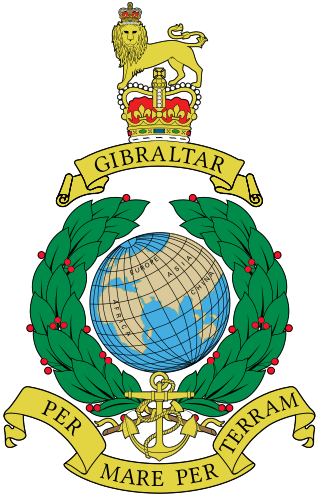
The Royal Marines, also known as the Royal Marines Commandos, and officially as the Corps of Royal Marines, are the United Kingdom's amphibious special operations capable commando force, one of the five fighting arms of the Royal Navy, and provide a company strength unit to the Special Forces Support Group (SFSG). The Royal Marines trace their origins back to the formation of the "Duke of York and Albany's maritime regiment of Foot" on 28 October 1664, and the first Royal Marines Commando unit was formed at Deal in Kent on 14 February 1942 and designated "The Royal Marine Commando".

Commando Training Centre Royal Marines (CTCRM) is the principal military training centre for the Royal Marines. It is situated near the villages of Lympstone and Exton, between the city of Exeter, and the town of Exmouth in Devon, England.

Royal Marines Barracks Chivenor is a British military base used primarily by 3 Commando Brigade. It is situated on the northern shore of the River Taw estuary, adjacent to the South West Coast Path, on the north coast of Devon, England. The nearest towns are Barnstaple and Braunton.

His Majesty's Naval Base, Portsmouth is one of three operating bases in the United Kingdom for the Royal Navy. Portsmouth Naval Base is part of the city of Portsmouth; it is located on the eastern shore of Portsmouth Harbour, north of the Solent and the Isle of Wight. For centuries it was officially known as HM Dockyard, Portsmouth: as a Royal Dockyard, Portsmouth functioned primarily as a state-owned facility for building, repairing and maintaining warships; for a time it was the largest industrial site in the world.

The Royal Marines Reserve (RMR) is the volunteer reserve force used to augment the regular Royal Marines. The RMR consists of some 600 trained ranks distributed among the four units within the UK. About 10 percent of the force are working with the Regular Corps on long-term attachments in all of the Royal Marines regular units. All the volunteers within the RMR must pass through the same rigorous commando course as the regulars. The former may be civilians with no previous military experience or may be former regular Royal Marines.

The Royal Marines Band Service is the musical wing of the Royal Navy and an independent element of the Royal Marines. It currently consists of five bands plus a training wing – the Royal Marines School of Music at HMS Nelson – and its headquarters is at HMS Excellent, Whale Island, Portsmouth.

HMS Sultan is a shore base of the Royal Navy in Gosport, Hampshire, England. It is the primary engineering training establishment for the Royal Navy and home to the Network Rail Advanced Apprenticeship Scheme and the EDF Energy engineering maintenance apprenticeship.

The Royal Marines Museum is a museum on the history of the Royal Marines from their beginnings in 1664 through to the present day. A registered charity, it is also a designated service museum under the terms of the National Heritage Act 1983 and receives Grant-in-Aid from the Ministry of Defence. During 2011 it formally became part of the National Museum of the Royal Navy, an executive non-departmental public body of the Ministry of Defence. The museum's galleries have been closed since 2017 pending relocation.
The history of the Royal Marines began on 28 October 1664 with the formation of the Duke of York and Albany's Maritime Regiment of Foot soon becoming known as the Admiral's Regiment. During the War of the Spanish Succession the most historic achievement of the Marines was the capture of the mole during the assault on Gibraltar in 1704. On 5 April 1755, His Majesty's Marine Forces, fifty Companies in three Divisions, headquartered at Portsmouth, Chatham and Plymouth, were formed by Order of Council under Admiralty control.

HMS Fisgard was a shore establishment of the Royal Navy active at different periods and locations between 1848 and 1983. She was used to train artificers and engineers for the Navy.
Royal Marines Cadets (SCC) are part of the Sea Cadets, a United Kingdom uniformed youth organization was formed in 1955 by the then Commandant General Royal Marines – General Sir Campbell Richard Hardy, KCB, CBE, DSO & Bar. The Royal Marines Cadets of the SCC specialise in activities such as orienteering, fieldcraft, and weapon handling.

RM Condor is a large Royal Marines base located near Arbroath in East Angus, Scotland. The base also houses 7 (Sphinx) Battery Royal Artillery, part of 29 Commando Regiment Royal Artillery.
RM Bickleigh, or Bickleigh Barracks, is a military installation at Bickleigh, South Hams which is currently used by 42 Commando.

Stonehouse Barracks, or RM Stonehouse, is a military installation at Stonehouse, Plymouth. It is the home of 3 Commando Brigade and referred to by commandos as 'the spiritual home of the Royal Marines'.

Forton Barracks was a military installation near Gosport in Hampshire, which served first as an Army barracks and then as a divisional headquarters for the Royal Marines. It subsequently served as a Royal Navy training establishment. Today, the site is occupied by St Vincent College.

Eastney Barracks was a military installation occupied by the Royal Marines and located at Eastney near Portsmouth.

The Royal Marine Depot, Deal was a military installation occupied by the Royal Marines and located in an area between Lower Walmer and South Deal in Kent. The Depot was first established in 1861, occupying part of the Royal Naval Hospital. In 1868 the Depot expanded and took over Walmer Barracks ; it was then generally referred to as the Royal Marine Depot, Walmer, but by the early 20th century it was officially listed as the Royal Marine Depot, Deal.
The Volunteer Cadet Corps (VCC) is a national youth organisation managed by the United Kingdom's Royal Navy and sponsored by the UK's Ministry of Defence. The VCC comprises:
In 1989 the Royal Navy was under the direction of the Navy Department in the UK Ministry of Defence. It had two main commands, CINCFLEET and Naval Home Command.



















